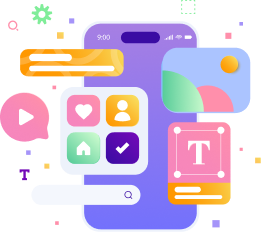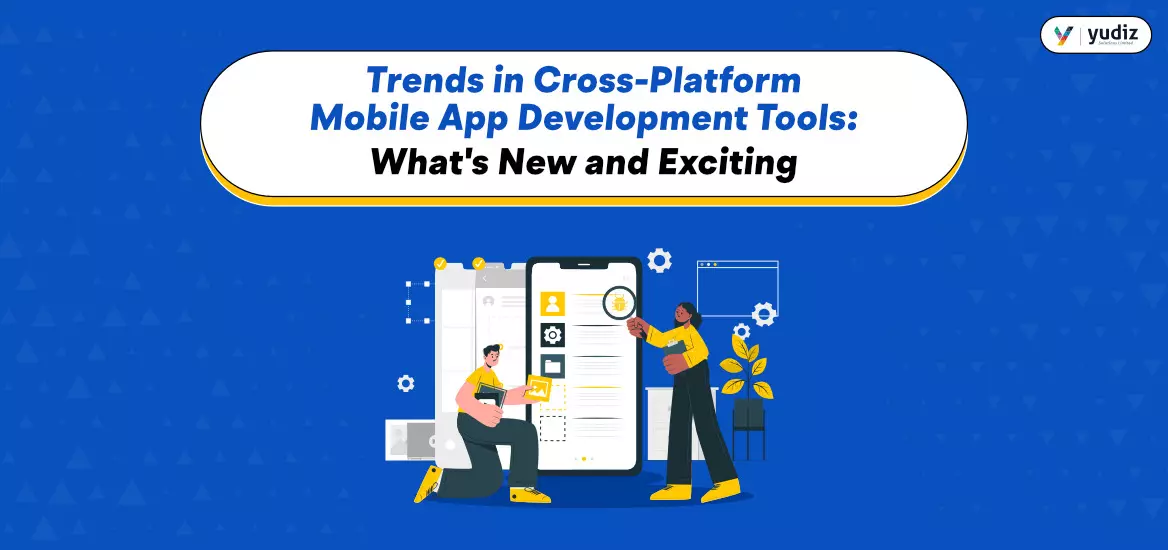Market Trends & Insights27th May 2024
In the ever-evolving mobile app ecosystem, app developers are looking for efficient ways to maintain their code within a unified codebase. Cross-platform mobile app development is an innovative way to develop a cost-effective mobile application with a faster time to market. Furthermore, cross-platform development fulfills the sole need of businesses – which is to appeal to a larger segment of the target audience.
Businesses of all niches are aiming to develop their apps with the cross-platform mobile development approach. The approach comprises a plethora of cross-platform development tools available in the market, which can be a bit overwhelming for developers and businesses. However, to define the success ratio of your apps, it is important to be familiar with the top cross-platform development frameworks. Then, you can choose the one that best suits
As a developer, staying updated on the latest cross-platform mobile development trends becomes essential. Staying updated will help you enable greater mobile app compatibility on multiple platforms—time to explore top cross-platform mobile app development trends leveraging the latest tools and frameworks.
Top 4 Reasons to Consider Cross-platform App Development Approach
The cross-platform approach revolves around maintaining a unified codebase for multiple platforms including Android and iOS. It saves businesses from the hassle of maintaining separate codebases for different platforms. Right from established brands to startups, businesses can benefit from cross-platform app development. Cross-platform becomes an invest-worthy approach due to the following reasons:-
Code Reusability
Code usability is a factor that separates it from many other mobile app development approaches. Since there is a single codebase to maintain Developers can use the same code to run on multiple operating devices including desktop, and mobile-based applications like Android or iOS.
Easier to Maintain Code
The cross-platform makes it much easier to make updates as there is a single source of truth. Since there is only a single database, developers don’t need to change the updates individually. This saves a lot of effort, time, and resource management responsibilities. from the developer’s end.
Reduced Expenses
As we mentioned since there is a single database to be managed the expenses are reduced to a significant extent. This is a great way for developers to remove hassle and for businesses to manage their maintenance expenses.
Seamless Cloud Integration
The cross-platform development approach supports a variety of Plugins integrations. Using cross-platform development tools you can allow your apps to gain limitless accessibility and scalability. Cloud integrations make it easier to release new features and make newer version updates. Cross-platforms provide seamless integration to some of the renounced cloud services and platforms with their software development kit and API integration. Hence, the cross-platform approach allows apps to connect with the cloud platform and features.
Latest Trends in the Cross-platform Mobile App Development Tools for 2024
1. Advanced User Experience With Native-like Features
In today’s digital age, user experience is prioritized. Gone are the days of a generic UI. Using cross-platform tools, you can use various UI components with native-like functionalities in your mobile app. Hence, you can tailor your app’s UI experience for a more consistent and intuitive user experience.
Also, using native UI features allows developers to design the look and feel app based on the design guidelines of the targeted platforms.
2. Increased Focus on Open-source Frameworks
Open-source tools and frameworks are highly adopted for mobile app development. The core reasons include wide developer communication, transparency for learning, and flexibility. Also, Using open-source cross-development frameworks can reduce the licensing fees and platform charges. A few of its concrete benefits include:-
- Faster development time – Due to readily available components, Developers just have to Drag and drop the interface rather than write the code from scratch.
- Better security – Due to an active community of developers, bugs are fixed accurately and quickly. As there is no room for bugs the adequate security parameters are met.
- An Active community – of developers ensures a great learning environment for both beginners and experienced developers. It allows them to share code snapples, videos, and tutorials with each other. Furthermore, It helps developers troubleshoot issues quickly and build complex mobile apps for targeted platforms.
3. Augmented Reality and Virtual Reality integrations
Augmented Reality technology has been a key enabler in allowing users to interact and immerse with the products in a completely realistic 3D virtual space. Cross-platform frameworks provide an abstraction layer to handle the complexities of integrating relevant APIs for AR VR solutions. These tools offer software development kits such as ARKit for iOS apps and ARcore for Android.
Several cross-platform tools have React Native, Unity, and Unreal comprised of pre-equipped components and Libraries. The tools that assist in rendering 3D objects and augmenting virtual objects in the physical environment for faster mobile app development. Moreover, frameworks like Flutter and Native have a solid community of developers helping developers resolve complex queries quickly. Hence, these tools can accelerate the development cycle of your app significantly.
4. Low code / No Code Solutions
The development time is now reduced to a significant extent. The credit goes to the latest trend – which is low code, no code solutions. Several cross-platform development tools facilitate the low code solutions. This is beneficial in rapid prototyping of apps and building basic apps much faster. Using cross-platform tools developers with minimal coding experience can develop basic apps with a simple user interface.
5. Ai and Machine Learning Integrations
Users now look for new ways to interact with apps in a way that’s tailored to their unique preferences. AI and machine learning analyze user behavior and deliver intuitive experiences that users essentially love. These features allow app developers and businesses to define the app features through valuable customer interaction and data.
Cross-platform tools can simplify the AI/ML integration into your apps. Cross-platform tools consist of readily available libraries and APIs making it easy for developers to incorporate AI functionalities. Thus, it eliminates the manual need to write code from scratch. thereby making it easy to incorporate AI/ ML features like:-
- Virtual assistance
- Image recognition
- Speech Recognition
- Voice Recognition
- Predictive maintenance
Some of the cross-platform frameworks like Flutter. React Native and Xamarin are used to seamlessly integrate relevant AI features with a paced-up AI/ML app development approach.
6. Metaverse Integrations – Interoperability in the Connected World
Metaverse integrations in a mobile way facilitate the interoperability of the connected worlds. Cross-platform app development tools allow the users, creators, and assets to inter-connect in a seamless ecosystem.
For example, powerful tools like Unity, Unreal, and Godox developers can assist in developing a cross-platform metaverse ecosystem. By using Unity, you can create 3D assets high-fidelity graphics, and fluid animations.
Leading Cross-platform Development Tools for Mobile App Development
1. Flutter
Established in 2017, this framework ranks among the top 3 most loved cross-platform frameworks. This framework uses the programming Dart built by Google has a strong community and is primarily loved for its simple UI interface and strong support of widgets. Let us evaluate the factors that make a trendy framework.
- Supports the development of multiple widgets
- Develop high-performing mobile applications in a paced-up environment with lower development and maintenance costs.
- Stronger community support and simple UI support for seamless animations.
- Hot Reload feature that assists the Flutter developers to view how the code changes will impact the User interface and overall experience.
- A viable option for businesses that want to launch their MVP (Minimum viable product ) in the market.
Extended support for other applications like web-based applications, and desktop applications.
Mobile apps using Flutter – Popular high-end mobile apps like BMW, Hamilton, and Dream11 are developed using Flutter. Btw, Our team of Flutter app developers has built some of the most incredible and highly used mobile apps. Have a Look!
Over the past few years, Flutter has been a trending choice and a viable option to develop applications faster without compromising on their performance.
2. React Native
React Native is another platform that is highly preferred for mobile app development due to its ability to create tailored high-performing apps. Let us have a look a its USP briefly.
- Seamless integrations with multiple APIs and third-party plugin tools.
- Hot reload enables real-time monitoring to view the impact of changes in the code.
- Allows nearly 80% code sharable for multiple targeted mobile app development platforms.
- Higher quality and performance tailored to the app’s unique requirements.
- Ability to create highly customizable apps and responsive user interfaces.
Btw, If you wish to build highly customizable and responsive mobile applications, then you must consult our team of experts and hire React Native developers for your project onboarding.
3. Xamarin
Xamarin is one of the leading cross-platform platforms developed by Microsoft specially designed to improve code compatibility. Some of its unique features are:
- Using Xamrin you can write your code in C# and use it for multiple devices reducing maintenance costs and time.
- Xamarin allows developers to access libraries and UI components to deliver a native-like feel for its users.
- Using its software development kits(SDKs) design interface for Android and UIkit for iOS development, it optimizes the user experience for each platform.
- Delivers a seamless integration with Visual Studio for a familiar cross-development approach.
- Provides valuable resources and API integrations designed for each platform. Hence, you can integrate unique native native functionalities allowing your app to deliver a platform-specific user interface.
4. PhoneGap
PhoneGap, developed by Adobe allows developers to seamlessly develop simple applications with a robust backend. What makes hone GAp stand out is its ability to code in multiple programming languages like C, C#, HTML, CSS, Javascript, etc.
- Essentially compatible with multiple target platforms like Andriod iOS etc.
- A viable option if you want to create simple apps without developing any complex native features
- Easy to call native APIs by choosing the framework.
- The best option if you want to create simple apps with native-like APIs like camera, geolocation, audio recorder integration
Read: Optimize Performance for Smooth AR VR Development: Tips and Techniques
Discover Ease of Access

Wrapping Up
By now you must be familiar with how cross-platform tools offer an array of benefits, one of which includes an accelerated app development cycle. Moreover, they offer active community support assisting mobile app developers of all calibers with the right guidance assistance and valuable resources.
Hence, it becomes equally important for both the developers and business to keep an eye on the latest cross-platform development trends. It will allow developers to leverage the best cross-platform tools tailored to the project’s needs. It‘s time you make the most of the cross-platform development trends by partnering with the best mobile app development company. In this way, you can leverage the top-notch cross-platform frameworks by developing smarter apps with an intuitive user experience.



















